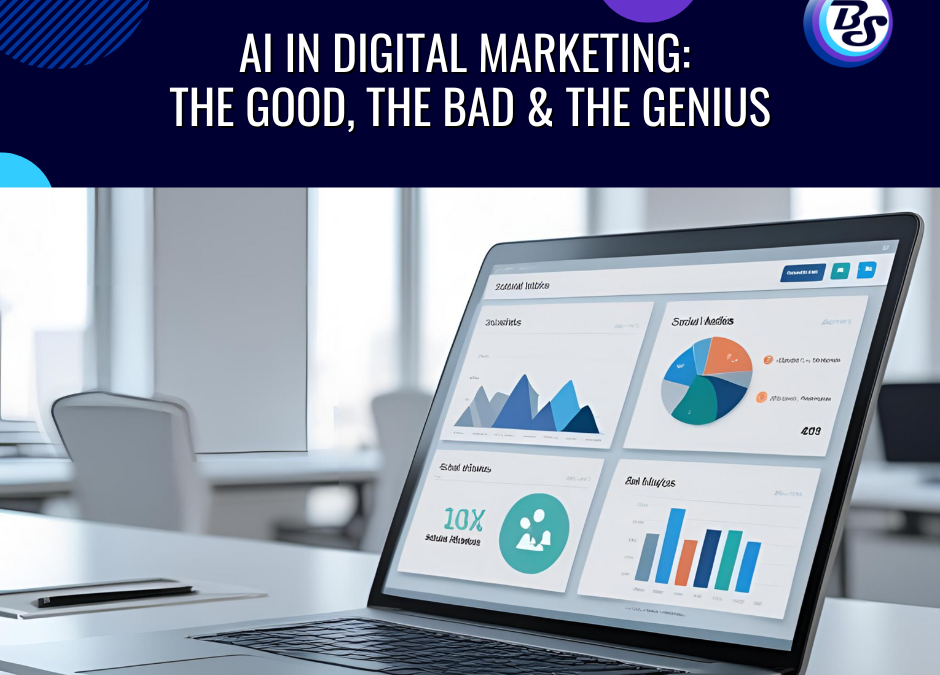If you’ve spent even five minutes in the world of digital marketing lately, you’ve probably heard the same two buzzwords over and over: Artificial Intelligence (AI). From snappy chatbots and predictive analytics to the emails that seem to know you better than your best friend, AI is changing the game. But is it all good news? What are the risks, and where is AI pure genius? At Brand Scrubbers, we believe in cutting through the hype and giving you the real scoop. So, let’s break down the good, the bad, and the truly genius sides of AI in digital marketing.
The Good: Why AI Is Digital Marketing’s Secret Weapon
Let’s start with the positives—because there are plenty. AI isn’t just a shiny trend. It’s a toolkit that, when used well, can make your digital marketing smarter, faster, and infinitely more effective.
1. Supercharged Personalization
Remember when personalization meant just slapping a customer’s name at the top of an email? Those days are long gone. Today, AI can analyze user behavior, segment your audience, and deliver content that feels uniquely tailored to each individual. AI-driven personalization can:
- Suggest products based on browsing history
- Serve up unique website experiences for each user
- Trigger emails at the exact right time
The result? Higher engagement, happier customers, and—most importantly—better conversion rates.
2. Data-Driven Insights (Without the Spreadsheet Headaches)
Digital marketing runs on data, but making sense of mountains of numbers is…well, let’s be honest, not why you got into business. AI tools can analyze massive datasets in seconds, spotting patterns and trends that would take a human months to decode. With AI, you can:
- Predict which leads are most likely to convert
- Identify which marketing channels drive the best ROI
- Adjust your strategy in real-time based on performance
Think of AI as your own 24/7 data scientist—no coffee breaks required.
3. Content Creation and Curation
Here’s a secret: AI isn’t just analyzing data. It’s also creating content. Tools like GPT (hi, that’s me!) can generate blog outlines, social media captions, and even draft entire articles. AI can also curate content from around the web, ensuring your audience always sees something fresh and relevant.
Does this mean robots are taking over your blog? Not quite. But AI can help fill content gaps, scale your output, and keep your brand voice consistent.
4. Smarter Ad Campaigns
Digital advertising is a high-stakes game. AI can optimize your bids, test creative variations, and allocate budget in real time to maximize results. The days of set-it-and-forget-it ads are over. With AI, your campaigns evolve as your audience does.
Google Ads’ Smart Bidding and Facebook’s AI-powered targeting are just the tip of the iceberg. Expect even more automation, with better ROI, in the years ahead.
The Bad: Where AI in Digital Marketing Can Go Off the Rails
Of course, it’s not all sunshine and conversions. AI has its pitfalls, especially when used without a clear strategy or ethical guardrails.
1. The “Black Box” Problem
AI can be a bit like a magician who refuses to reveal their tricks. Many AI models are “black boxes”—they work, but you don’t always know how. This can make it tough to explain why certain decisions were made (“Why did the algorithm stop showing my ad to women aged 35-44?”) and can erode trust with stakeholders.
2. Over-Automation & The Human Touch
Let’s face it: nobody wants to feel like they’re talking to a robot. Over-automation can make your brand feel cold or impersonal. AI can suggest, write, and automate, but it can’t replace the creativity, empathy, and nuance of a real human marketer.
If you’ve ever received an awkwardly worded chatbot reply or clicked an ad that seemed just a little too creepy, you know what we mean.
3. Data Privacy & Ethical Gray Areas
AI in digital marketing relies on data—lots of it. But with great data comes great responsibility. Collecting, storing, and using personal data raises privacy concerns. Regulations like GDPR and CCPA are just the start; customers are more aware than ever about how their data is used.
Misusing AI, whether intentionally or by accident, can backfire spectacularly. Think about biased algorithms, invasive targeting, or tone-deaf AI-generated content. All can tank your brand’s reputation overnight.
4. Dependence on Third-Party Platforms
Many AI tools are built into platforms like Google, Facebook, or HubSpot. That’s convenient, but it also means you’re at the mercy of their algorithms and updates. When the rules change, your results can vanish overnight.
The Genius: Where AI and Digital Marketing Are Headed
Now for the exciting part. Where is AI in digital marketing going next? The possibilities are mind-blowing—and, yes, a little intimidating.
1. Hyper-Personalization at Scale
Imagine a website that completely reconfigures itself for each visitor. Product recommendations, colors, even the navigation menu—everything adapts based on a user’s behavior and preferences. AI-driven hyper-personalization isn’t science fiction; it’s already starting to happen.
The genius here? Brands can create truly one-to-one experiences, even with millions of users.
2. Predictive & Prescriptive Marketing
Forget reacting—what if you could predict what your customers want before they even know it? AI is moving from descriptive (“What happened?”) and diagnostic (“Why did it happen?”) to predictive (“What will happen?”) and prescriptive (“What should I do?”).
- AI can forecast sales trends
- Suggest next-best-offers to customers
- Alert you to churn risks before they’re a problem
That’s not just smart marketing—that’s genius-level business strategy.
3. AI-Generated Creative (With a Human Twist)
AI isn’t just about logic and numbers. It’s starting to help with creative work, too. From generating original ad copy and graphics to assisting with video editing, AI is a powerful sidekick for creative teams.
But here’s the key: the best results come when humans and AI work together. AI can handle the heavy lifting, but your vision, brand voice, and storytelling make the final product shine.
4. Real-Time Customer Journeys
AI is making it possible to react to customer behavior instantly. Think personalized pop-ups, dynamic content, and chatbots that escalate to a real person at just the right moment. Real-time marketing used to be reserved for huge brands with massive budgets. Now, thanks to AI, it’s within reach for businesses of all sizes.
How to Use AI Effectively in Your Digital Marketing
So, how do you harness the genius of AI—without falling into the common traps? Here are Brand Scrubbers’ top tips:
- Start with Strategy: Don’t jump on every AI tool just because it’s new. Identify your business goals and find tools that help you get there.
- Keep the Human Touch: Use AI to automate the routine, but let real people handle creativity, empathy, and high-level strategy.
- Prioritize Data Ethics: Be transparent with your audience about how you use data. Respect privacy, follow regulations, and build trust.
- Test, Learn, Repeat: AI is evolving fast. Test new approaches, measure results, and don’t be afraid to pivot if something isn’t working.
- Invest in Training: Whether it’s your team or yourself, invest in learning about AI. The more you know, the better you’ll leverage its power.
Wrapping Up: AI in Digital Marketing is Here to Stay
AI in digital marketing isn’t a fad—it’s a fundamental shift in how we connect with customers, analyze data, and create experiences. But like any tool, it’s as good (or bad) as the strategy behind it.
The good? AI saves time, drives engagement, and unlocks insights you’d never find on your own. The bad? Over-automation, privacy risks, and black-box algorithms can trip you up. The genius? Hyper-personal, predictive, and creative marketing at a scale we’ve never seen before.
At Brand Scrubbers, we’re here to help you scrub away the confusion and put AI to work for your brand—ethically, creatively, and strategically. Ready to make digital marketing magic? Let’s talk.


Recent Comments